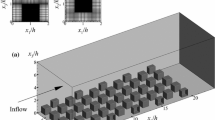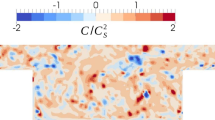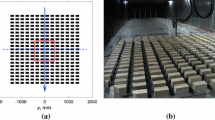Abstract
A large-eddy simulation (LES) method is used to investigate the characteristics and scaling of flows over realistic urban geometries. The LES method is first validated with wind-tunnel measurements for the flow over a staggered array of cubes and the grid dependence behaviour of the LES is tested. It is then applied to simulate the flows over four different realistic urban surfaces with sizes of about 1000 m \(\times \) 500 m. After examining the overall flow patterns and turbulence characteristics, the time- and horizontally space-averaged profiles for the four cases are investigated. It is found that, in all cases, the vertical profiles of the mean streamwise velocity component can be characterized by an inflection point which can be identified as the height of the urban canopies. A new simple method is then proposed to predict this height for the realistic urban canopies based on the plan area fraction of the surfaces. By using this urban canopy height as the normalization length scale for the flows over realistic urban geometries, it is found that the vertical profiles of the dispersive stress, effective mixing length, and sectional drag coefficient show similar patterns as those of uniform height idealized urban canopies. This result would be useful for the development of urban flow parametrizations.














Similar content being viewed by others
Data availability
The datasets generated during and/or analyzed during the current study are available from the corresponding author on reasonable request.
References
Barlow J, Coceal O (2009) A review of urban roughness sublayer turbulence. Technical Report, Met Office, Department of Meteorology, Reading University. p. 507
Blunn LP, Coceal O, Nazarian N, Barlow JF, Plant RS, Bohenstengel SI, Lean HW (2022) Turbulence characteristics across a range of idealized urban canopy geometries. Boundary-Layer Meteorol 182:275–307
Castro IP (2017) Are urban-canopy velocity profiles exponential? Boundary-Layer Meteorol 164:337–351
Castro IP, Leonardi S (2010) Very-rough-wall channel flows: a DNS study. In: Nickels T (eds) IUTAM symposium on the physics of wall-bounded turbulent flows on rough walls IUTAM bookseries, vol 22
Cheng H, Castro I (2002) Near wall flow over urban-like roughness. Boundary-Layer Meteorol 104:229–259
Cheng WC, Liu CH (2011) Large-eddy simulation of flow and pollutant transports in and above two-dimensional idealized street canyons. Boundary-Layer Meteorol 139:411–437
Cheng WC, Porté-Agel F (2015) Adjustment of turbulent boundary-layer flow to idealized urban surfaces: a large-eddy simulation study. Boundary-Layer Meteorol 155:249–270
Cheng WC, Porté-Agel F (2021) A simple mixing-length model for urban canopy flows. Boundary-Layer Meteorol 181:1–9
Cheng WC, Liu CH, Ho YK, Mo Z, Wu Z, Li W, Chan LYL, Kwan WK, Yau HT (2021) Turbulent flows over real heterogeneous urban surfaces: wind tunnel experiments and Reynolds-averaged Navier-Stokes simulations. Build Simul 14:1345–1358
Coceal O, Belcher SE (2004) A canopy model of mean winds through urban areas. Q J R Meteorol Soc 130:1349–1372
Coceal O, Thomas TG, Castro IP, Belcher SE (2006) Mean flow and turbulence statistics over groups of urban-like cubical obstacles. Boundary-Layer Meteorol 121:491–519
Di Sabatino S, Solazzo E, Paradisi P, Britter R (2008) A simple model for spatially-averaged wind profiles within and above an urban canopy. Boundary-Layer Meteorol 127:131–151
Fang J, Porté-Agel F (2015) Large-eddy simulation of very-large-scale motions in the neutrally stratified atmospheric boundary layer. Boundary-Layer Meteorol 155:397–416
Garratt JR (1994) The atmospheric boundary layer, 3rd edn. Cambridge University Press, Cambridge, p 336
Giacomini B, Giometto MG (2021) On the suitability of second-oder accurate finite-volume solvers for the simulation of atmospheric boundary layer flow. Geosci Model Dev 14:1409–1426
Giometto MG, Christen A, Meneveau C, Fang J, Krafczyk M, Parlange MB (2016) Spatial characteristics of roughness sublayer mean flow and turbulence over a realistic urban surface. Boundary-Layer Meteorol 160:425–452
Grimmond CSB, Oke TR (1999) Aerodynamic properties of urban areas derived from analysis of surface form. J App Meteorol 38:1262–1291
Hertwig D, Gough HL, Grimmond S, Barlow JF, Kent CW, Lin WE, Robins AG, Hayden P (2019) Wake characteristics of tall buildings in a realistic urban canopy. Boundary-Layer Meteorol 172:239–270
Kanda M, Inagaki A, Miyamoto T, Gryschka M, Raasch S (2013) A new aerodynamic parametrization for real urban surfaces. Boundary-Layer Meteorol 148:357–377
Kono T, Tamura T, Ashie Y (2010) Numerical investigations of mean winds within canopies of regularly arrayed cubical buildings under neutral stability conditions. Boundary-Layer Meteorol 134:131–155
Leonardi S, Castro IP (2010) Channel flow over large cube roughness: a direct numerical simulation study. J Fluid Mech 651:519–539
Li XX, Liu CH, Leung DYC, Lam KM (2006) Recent progress in CFD modelling of wind field and pollutant transport in street canyons. Atmos Environ 40:5640–5658
Macdonald RW (2000) Modelling the mean velocity profile in the urban canopy layer. Boundary-Layer Meteorol 97:25–45
Macdonald RW, Griffiths RF, Hall DJ (1998) An improved method for the estimation of surface roughness of obstacle arrays. Atmos Environ 32:1857–1864
Moon K, Hwang JM, Kim BG, Lee C, Choi J (2014) Large-eddy simulation of turbulent flow and dispersion over a complex urban street canyon. Environ Fluid Mech 14:1381–1403
Nazarian N, Krayenhoff ES, Martilli A (2020) A one-dimensional model of turbulent flow through “urban” canopies (mlucm v2.0): updates based on large-eddy simulation. Geosci Model Dev 13:937–953
Oke TR, Mills G, Christen A, Voogt JA (2017) Urban climates. Cambridge University Press, Cambridge, p 519
OpenFOAM (2018) User guide. OpenFOAM
Raupach MR, Finnigan JJ, Brunei Y (1996) Coherent eddies and turbulence in vegetation canopies: the mixing-layer analogy. Boundary-Layer Meteorol 78:351–382
Santiago JL, Martilli A (2010) A dynamic urban canopy parameterization for mesoscale models based on computational fluid dynamics Reynolds-averaged Navier-Stokes microscale simulation. Boundary-Layer Meteorol 137:417–439
Schmid MF, Lawrence GA, Parlange MB, Giometto MG (2019) Volume averaging for urban canopies. Boundary-Layer Meteorol 173:349–372
Schumann U (1975) Subgrid scale model for finite difference simulations of turbulent flows in plane channels and annuli. J Comput Phys 18:376–404
Spalding DB (1962) A new analytical expression for the drag of a flat plate valid for both the turbulent and laminar regimes. Int J Heat Mass Transf 5:1133–1138
Sützl B, Rooney GG, van Reeuwijk M (2021) Drag distribution in idealized heterogeneous urban environments. Boundary-Layer Meteorol 178:225–248
Xie ZT, Castro IP (2009) Large-eddy simulation for flow and dispersion in urban streets. Atmos Environ 43:2174–2185
Xie Z, Castro IP (2016) LES and RANS for turbulent flow over arrays of wall-mounted obstacles. FlowTurbulence Combust 76:291-312
Xie ZT, Fuka V (2018) A note on spatial averaging and shear stresses within urban canopies. Boundary-Layer Meteorol 167:171–179
Xie ZT, Coceal O, Castro IP (2008) Large-eddy simulation of flows over random urban-like obstacles. Boundary-Layer Meteorol 129:1–23
Yao L, Liu CH, Mo Z, Cheng WC, Brasseur GP, Chao CYH (2022) Statistical analysis of the organized turbulence structure in the inertial and roughness sublayers over real urban area by building-resolved large-eddy simulation. Build Environ 207B(108):464
Yoshida T, Takemi T (2018) Properties of mixing length and dispersive stress in airflows over urban-like roughness obstacles with variable height. SOLA 14:174–178
Zhu X, Iungo GV, Leonardi S, Anderson W (2017) Parametric study of urban-like topographic statistical moments relevant to a priori modelling of bulk aerodynamic parameters. Boundary-Layer Meteorol 162:231–253
Acknowledgements
This study is supported by the National Natural Science Foundation of China and Macau Science and Technology Development Joint Fund (NSFC-FDCT), China and Macau (41861164027) and the Fundamental Research Funds for the Central Universities, Sun Yat-sen University (2021qntd29). The authors would like to thank the anonymous reviewers for helpful comments.
Author information
Authors and Affiliations
Corresponding author
Ethics declarations
Conflict of interest
The authors have no competing interests to declare that are relevant to the content of this article.
Additional information
Publisher's Note
Springer Nature remains neutral with regard to jurisdictional claims in published maps and institutional affiliations.
Rights and permissions
Springer Nature or its licensor holds exclusive rights to this article under a publishing agreement with the author(s) or other rightsholder(s); author self-archiving of the accepted manuscript version of this article is solely governed by the terms of such publishing agreement and applicable law.
About this article
Cite this article
Cheng, WC., Yang, Y. Scaling of Flows Over Realistic Urban Geometries: A Large-Eddy Simulation Study. Boundary-Layer Meteorol 186, 125–144 (2023). https://doi.org/10.1007/s10546-022-00749-y
Received:
Accepted:
Published:
Issue Date:
DOI: https://doi.org/10.1007/s10546-022-00749-y




